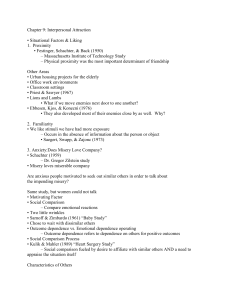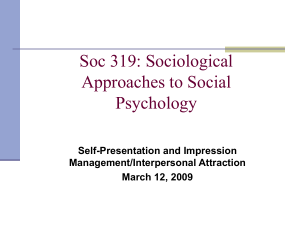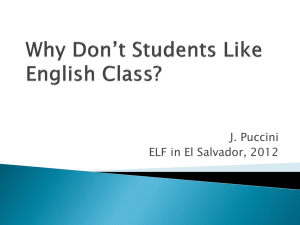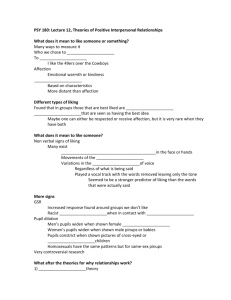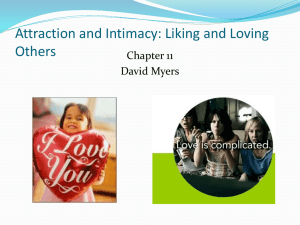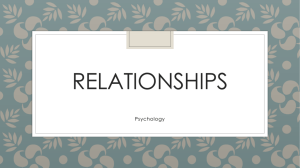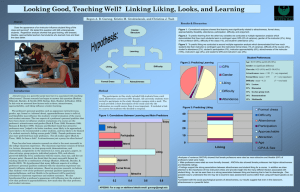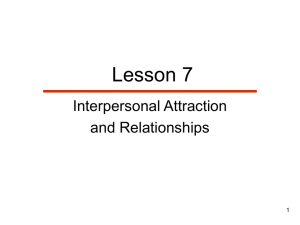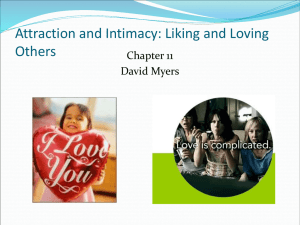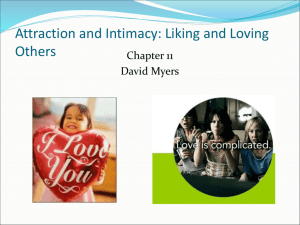Introduction & Theoretical Perspectives
advertisement
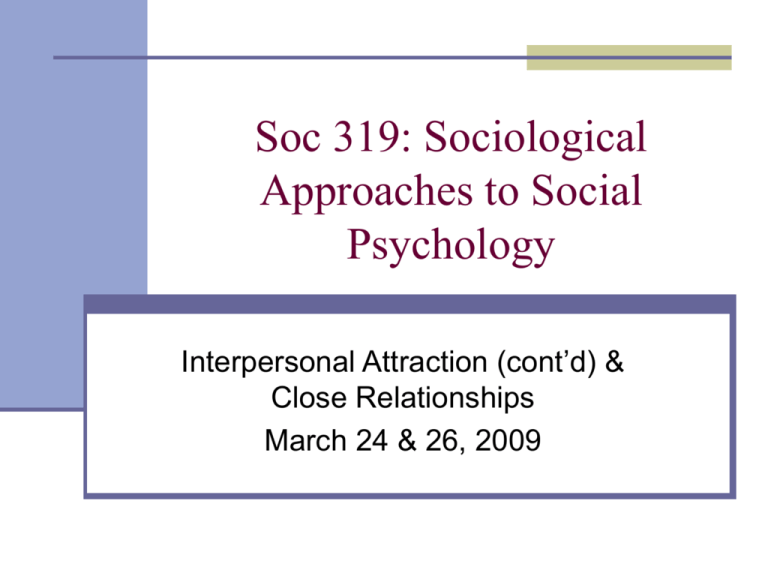
Soc 319: Sociological Approaches to Social Psychology Interpersonal Attraction (cont’d) & Close Relationships March 24 & 26, 2009 A. Interpersonal Attraction: Who do we choose? 1. “Availables” a. Institutional structures i. Despite cultural myth of “freedom of choice,” institutional structures guide who we meet, and how we meet them. ii. Neighborhoods, schools, workplaces, and social networks are bound by social class & race/ethnicity, and - in earlier eras – religion. A. Interpersonal Attraction: Who do we choose? b. Physical proximity Exchange theory: Easy to interact with those who are near by. The “costs” are low because there is little investment in terms of time, effort, or travel costs. c. Familiarity: Importance of familiarity: Proximity familiarity liking. Mere exposure effect (Zajonc, 1968). Repeatedly viewing a person or object over time leads to liking. We respond with mild discomfort to anything or anyone new. With repeated exposure, the feelings of anxiety decrease and the new object becomes familiar. B. What characteristics do we seek in a partner? 1. Physical attractiveness a. Buss & colleagues: Universal importance of attractiveness; indicator of “fitness.” Physical attractiveness-economic prospects “trade off” when selecting long-term partners. Women have greater vested interest in offspring well-being. Attractive women can “trade up.” [Economists’ data support this] Data from 37 countries offer support for hypothesis. b. Stevens, Owens and Schaefer (1990) Found men and women “match” on both physical attractiveness and socioeconomic prospects. Supports “matching” hypothesis. B. What characteristics do we seek in a partner? 1. Physical attractiveness b. Debates over importance of attractiveness i. Most people seek “beautiful” partners (recall “halo effect”). Self-fulfilling prophecy (Snyder) Ii. Equity guides partner choices. Expectancy value theories: higher likelihood of success when we strive for others of like “quality.” (Level of Aspiration) Equity theories: Inequities lead to imbalance and desire to offset such imbalances. Normative influences discourage “mismatches” (Forgas,1993). Couples who match in attractiveness Abhishek Bacchanal and Aishwarya Rai Elizabeth Moss and Fred Armisen Couples who don’t match in attractiveness (support for Buss??) Donald Trump and Melania Knauss B. What characteristics do we seek in a partner? 2. Similarity a. Matching hypothesis i. Equity theory ii. Expectancy value theories iii. Consistency theories “Matching” or Homogamy Hypothesis: Shifting Criteria Over Time Religion: Was important influence; has waned since mid-20th century; Race: Important influence throughout 20th century, though drastic reduction in importance. Specific racegender patterns persist. Social class: Key stratifier today, reflecting institutional structures, timing of partner selection (Mare; Kalmijn). Powerful implications for social stratification and transmission of class. Importance of third-party influences endorsing homogamy has waned throughout 20th century (Kalmijn), esp. among higher-order partnerings. Trends in U.S. Interracial Marriage Number (millions) U.S. Interracial Couples in Millions and as Percent of all Married Couples, 1970-2000 6 5 4 3 2 1 0 5.4 Number (millions) 2.9 2 Percent of all married couples 0.7 1970 1980 1990 2000 B. What characteristics do we seek in a partner? 3. Complementarity or “opposites attract” (Winch,1958) Limited empirical support for notion that people seek those with different personality traits that complement their own. Most data support similarity of personality traits among partners. II. Close Relationships A. Liking vs. Loving (Rubin) 1. Using survey items to measure love a. Affiliative/dependent need b. Predisposition to help c. Exclusiveness/absorption 2. Does the scale differentiate loving and liking? Rubin (1970) Scale of Liking & Loving Items Measuring Liking I feel that _____________ is a very stable person. I have confidence in ______________’s opinions. Items Measuring Loving I feel strong feelings of possessiveness towards ____________. I like it when __________ confides in me. I would do almost anything for _____________. Rubin asked a number of participants to fill out his questionnaires based upon how they felt both about their partner and a good friend. The results revealed that good friends scored high on the liking scale, but only significant others rated high on the scales for loving. B. Sternberg Taxonomy of Love Relationships 1. Ingredients a. Intimacy b. Passion c. Commitment 2. Types of love a. Non-love b. Liking c. Infatuation d. Empty love e. Romantic love f. Companionate love g. Fatuous love h. Consummate love http://www.youtube.com/watch?v=PRhCTnkd3vM 3. Critiques Sternberg Taxonomy Sternberg Taxonomy (easier to read) Combinations of intimacy, passion, and commitment Intimacy Liking or friendship Passion x Infatuation or limerence x Empty love x Romantic love x Companionate love x Fatuous love Consummate love Commitment x x x x x x x C. Attachment Styles (Shaver et al.) 1. Attachment theory 2. Attachments styles a. Secure b. Avoidant c. Anxious-ambivalent Shaver categories Secure I find it relatively easy to get close to others and am comfortable depending on them and having them depend on me. I don't often worry about being abandoned or about someone getting too close to me. Avoidant. I am somewhat uncomfortable being close to others; I find it difficult to trust them completely, difficult to allow myself to depend on them. I am nervous when anyone gets too close, and often, love partners want me to be more intimate that I feel comfortable being. Anxious/Ambivalent. I find that others are reluctant to get as close as I would like. I often worry that my partner doesn't really love me or won't want to stay with me. I want to merge completely with another person, and this desire sometimes scares people away. D. Equity theory in relationships Hatfield and Rapson argue that equity is difficult to assess in long-term relationships. “Rewards” are varied and interchangeable E. Key predictors of marital dissolution Interactional styles (Gottman) http://www.youtube.com/watch?v=E94xTxEydN4&featur e=related http://www.youtube.com/watch?v=Xw9SE315GtA&NR= 1 Young age at marriage Financial troubles Having divorced parents Age/gender of children (?) Birth cohort Educational attainment Gottman (1999): Interactional predictors of divorce, based on Marriage Lab Harsh startups. You find yourself beginning a discussion with your spouse using criticism, sarcasm, or harsh words. The Four Horsemen. Criticism, contempt, defensiveness, and stonewalling (withdrawal) invade your communication. Flooding. Your spouse’s negativity is so overwhelming that it leaves you shell-shocked. You disengage emotionally from the relationship. Body Language. Your heart rate increases, your blood pressure mounts, and your ability to process information is reduced. This makes it harder to pay attention to what your partner is saying. Failed Repair Attempts. Efforts made by either partner to deescalate the tensions during a touchy discussion fail to work. Bad Memories. Couples who are "stuck" in a negative view of their spouse and marriage often rewrite their past – for the worse.
